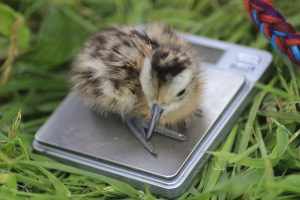
CurlewCam is our very own live streaming nest camera and has just finished the streaming of 2018’s nesting attempt for viewers across the country. The camera allows the public, and the Curlew Country team, to get an up close and personal view of these secretive birds during the nesting season.
The curlew’s ability, even as Britain’s largest wader, to hide its nest so efficiently is something that impresses us every year. Their colouration is designed to act as camouflage in their natural habitats, and they will walk long distances to the nest, often zig-zagging through a field, to keep its location concealed. It takes many hours of patience and diligent watching to locate them, and even with the hours of work put in by trained field ornithologists the nests are not always found.

Often at the start of the season the birds will leave the nest at your approach, relying on the camouflaged colours of the eggs to keep them hidden and protected. Later in to the nesting period they will sit incredibly tight, in some circumstances not leaving at all when approached. The nest itself is little more than a scrape in the grass, created by the curlew swivelling on its chest. All these factors add make the nests tricky to find, which makes it even more of a privilege to watch their progress on CurlewCam.
The nest found for Curlew Cam this year was in a different location to 2017, and a pair which had not been located previously. The team went in to set up the nest camera as quickly and efficiently as possible, to minimise the time spent at the nest. Retreating to a safe distance, the birds were then observed to ensure they accepted the camera and returned to the nest. The male was the first to return, and although he acted suspiciously he eventually settled down to continue incubation.
With a slightly different approach this season, the eggs in the nest were in fact removed and incubated artificially, and temporarily replaced with dummy eggs. This offered an extra level of protection from predation, which can still occur despite the deterrent electric fence. These eggs were then returned to the pair at pipping stage. Pipping is when the chick first starts to emerge from the egg, showing cracking, crazing or small holes in the outer shell. It can take another 3 days for the chick to fully emerge from the egg.
When the day came for the chicks to hatch, we were all eagerly watching and waiting, trying to catch the first glimpse of a fluffy chick from underneath the parents. It was difficult to tell how many chicks were out from watching the camera, and many people were phoning, e-mailing or messaging with excited updates on what they had seen and guesses of how many there were.

A day later and project ornithologist Tony Cross made the tough decision to try go to ring and radio tag the chicks in the nest. The timing for this is crucial. The chicks need to be sufficiently brooded to be warm and dry but leave it too long and the chicks will already have left making them very difficult to locate in the long grass. On arrival, it was discovered that 3 chicks had hatched, but sadly one had died soon after hatching. The cause of this is unknown, but some degree of failure is expected in both wild nests and incubated clutches.
The two remaining chicks were taken aside to be weighed, fitted with rings and given their own unique radio tag. These tags are fitted to the down on the chicks back and will fall off when the down is replaced with adult feathers. The radio tags allow the chicks to be relocated within the following weeks, keeping us updated on their progress.

On the first return to the site, about a week later, the adult birds were acting very defensively. Their alarm calling and swooping to fend off buzzards, crows and other birds acted as a certain sign that the chicks were still alive. A casual curlew in the nesting season is not usually a good sign. We breathed a sigh of relief knowing that the little chicks were surviving, hidden amongst the long grass of this tucked away meadow.
The next visit saw Tony return with the radio tracking device and start the hunt through the fields, listening out for the faint beeping indicating that a chick is nearby. The adults were not flying overhead as before, a worrying sign, just the occasional bubbling cry or curlee could be heard in the distance. The radio tracker started to pick up a faint signal however, which was tracked across a nearby field to the bottom of a tree. Here in the grass was a single radio tag, tufted with downy feathers, where it had been plucked away, most likely by an avian predator Another lone tag was find a short distance away in the grass. Even the team, used to such losses, feel sad at every one.

The sad ending to this tale brings to the foreground the grim reality that faces these chicks. Predation is a key barrier to the success of nests, even with predation control and protection measures in place. This same story has been seen by the project time and time again, with 2 years of nest monitoring see no chicks survive. Which brings us to 2018, and the licence granted to incubate eggs and rear the chicks to fledgling stage. This gives us some hope for the future and will help to boost the population numbers until long term solutions can be found and implemented.
The reality is that the situation for breeding curlew is desperate, and that desperate measures are needed. Curlew Country believe in acting fast and efficiently, to win the race against time to save curlew.
[paypal_donation_button]

